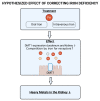Iron Deficiency and Nephrotoxic Heavy Metals: A Dangerous Interplay?
- PMID: 36982393
- PMCID: PMC10049453
- DOI: 10.3390/ijms24065315
Iron Deficiency and Nephrotoxic Heavy Metals: A Dangerous Interplay?
Abstract
Heavy metals are common in our environment, and all individuals are exposed to them to some extent. These toxic metals have several harmful effects on the body, including the kidney, which is a very sensitive organ. Indeed, heavy metal exposure has been linked to an increased risk of chronic kidney disease (CKD) and its progression, which may be explained by the well-established nephrotoxic effects of these metals. In this hypothesis and narrative literature review, we will shed light on the potential role that another highly common problem in patients with CKD, iron deficiency, may play in the damaging effects of heavy metal exposure in this patient group. Iron deficiency has previously been linked with an increased uptake of heavy metals in the intestine due to the upregulation of iron receptors that also take up other metals. Furthermore, recent research suggests a role of iron deficiency in the retention of heavy metals in the kidney. Therefore, we hypothesize that iron deficiency plays a crucial role in the damaging effects of heavy metal exposure in patients with CKD and that iron supplementation might be a strategy to combat these detrimental processes.
Keywords: chronic kidney disease; heavy metals; iron deficiency; metal transporters; nephrotoxic.
Conflict of interest statement
M.F.E. has declared receiving consultant fees from Vifor Pharma and Cablon Medical, serving on the Advisory Board for Cablon Medical and GlaxoSmithKline, and receiving speaker fees from Vifor Pharma, Pharmacosmos, and Astellas. D.J.T. has declared receiving grants from Chiesi Pharmaceuticals and ZONMW, and serving on the Advisory Board for Sanquin and PureIMS. M.H.D.B. has declared receiving consultancy fees from Vifor Pharma, Cablon Medical, Kyowa Kirin, Sanofi Genzyme, and Astellas, and receiving research support from Vifor Pharma and Sanofi Genzyme.
Figures




References
-
- Heavy Metal Emissions in Europe. [(accessed on 10 January 2023)]. Available online: https://www.eea.uropa.eu/ims/heavy-metal-emissions-in-europe.
-
- Niu Y., Chen F., Li Y., Ren B. Trends and Sources of Heavy Metal Pollution in Global River and Lake Sediments from 1970 to 2018. Springer; Cham, Switzerland: 2020. pp. 1–35. - PubMed

